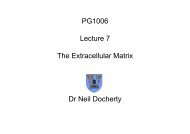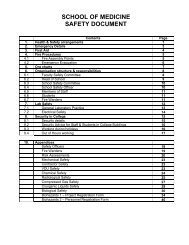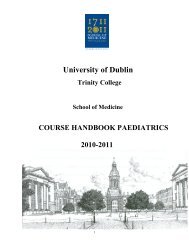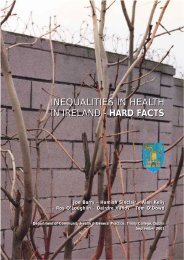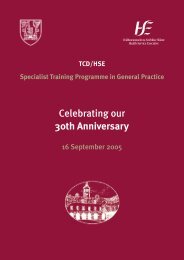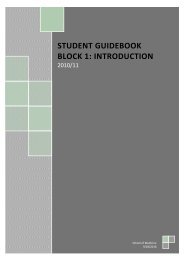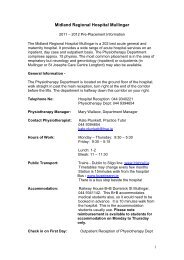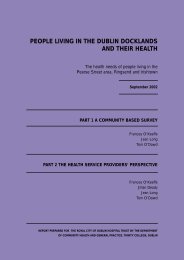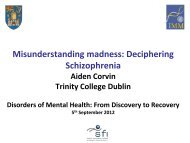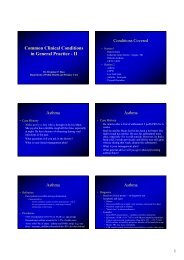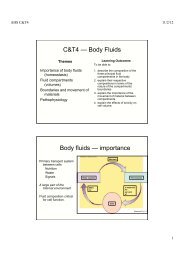year-2-study-guide-2.. - School of Medicine - Trinity College Dublin
year-2-study-guide-2.. - School of Medicine - Trinity College Dublin
year-2-study-guide-2.. - School of Medicine - Trinity College Dublin
Create successful ePaper yourself
Turn your PDF publications into a flip-book with our unique Google optimized e-Paper software.
Neurochemistry<br />
• A description <strong>of</strong> the cell types in the brain and common techniques that enable<br />
chemicals with neurotransmitter-like properties to be identified<br />
• The criteria that need to be satisifed in order for a chemical to be classified as<br />
a neurotransmitter<br />
• A knowledge <strong>of</strong> the biogenic amines (acetylcholine, dopamine, noradrenaline,<br />
adrenaline, serotonin) and the properties that allow them to be classified as<br />
neurotransmitters<br />
• A knowledge <strong>of</strong> glutamate and GABA and the properties that allow them to be<br />
classified as neurotransmitters<br />
• A knowledge <strong>of</strong> atypical neurotransmitters (NO, CO, D-serine, neuropeptides,<br />
purines) and the properties that allow them to be classified as<br />
neurotransmitters<br />
• The role that apoptotic and necrotic cell death play in neurodevelopment and<br />
neurodegeneration.<br />
Neuropharmacology<br />
• Describe and evaluate the scientific basis <strong>of</strong> current and novel<br />
pharmacological approaches to the treatment <strong>of</strong> neurological and psychiatric<br />
illnesses, including drug efficacy and major side effects<br />
• Assess the pharmacological evidence for the involvement <strong>of</strong> different<br />
mechanisms in normal and abnormal functioning <strong>of</strong> the nervous system.<br />
• Define efficacy goals and differences between different classes and subclasses<br />
<strong>of</strong> centrally acting drugs including:<br />
• Hypnotics, sedatives and anxiolytics<br />
• General and local anaesthetics, anticonvulsants<br />
• Narcotic and non-narcotic analgesics<br />
• Antipsychotic and antidepressants<br />
• Relate the different effects <strong>of</strong> classes <strong>of</strong> CNS drugs to their sites and<br />
mechanisms <strong>of</strong> action.<br />
• Distinguish acute and chronic effecst <strong>of</strong> CNS active drugs and the basis <strong>of</strong><br />
physical and psychological dependence.<br />
Methods <strong>of</strong> Assessment<br />
The methods <strong>of</strong> assessment are under review. Last <strong>year</strong> they consisted <strong>of</strong> the<br />
following:<br />
Written Papers<br />
Paper 1 (<strong>2.</strong>5 hours):<br />
Physiology, Pharmacology, Psychiatry (EMQs, MCQs )<br />
Paper 2 (2 hours):<br />
Biochemistry( Answer one essay question from a choice <strong>of</strong> two),<br />
Neuroanatomy (Four SAQs)<br />
Neuroanatomy Practical Examination<br />
This is a viva voce examination (one-to-one interview) with a member <strong>of</strong> Staff <strong>of</strong> the<br />
Department<br />
Distribution <strong>of</strong> Marks<br />
Paper 1: Physiology (20%), Pharmacology (20%), Psychiatry (20%)<br />
Paper 2: Biochemistry (20%), Neuroanatomy (10% paper, 10% practical)<br />
Overall Total: 100%<br />
41





